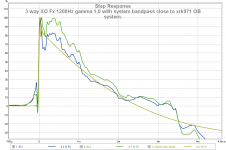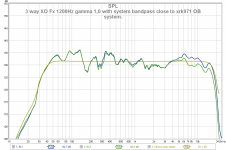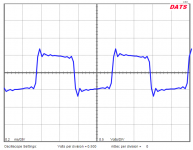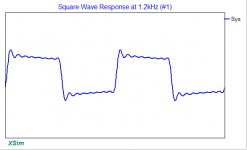Co-opting REW impulse response import for alternative purposes is a great technique; and I am not first to use it for looking at square wave results. Use of swept square wave allows poking about to see how waveform envelope changes with frequency for a given measurement setup. With experience (endless practice and goofing around) it is possible to use repertoire of software arsenal to decompose the square wave and look at specific amplitude and phase of component sine waves; useful in tweaking filters and alignment. Sure, a single base frequency square wave may be used, but always leads to checking elsewhere in spectrum in making useful assessments.
When approached as speaker alignment tools such techniques help make minutia that are difficult to interpret from IR and step response stand out.
Here are overviews of 50Hz-4kHz swept square response of R-1 and R-2 with long and short windows of the impulse responses:

The comparison makes it easy to see that room influence under measurement conditions as direct to reflected ratio require judicious use of windows to get valid and useful results for analysis and interpretation.
You initial posted square wave response is prime example; step response tells you that system should be capable of good square wave response, but that without experiences like this you would be blasting away lots of effort.
Here is example of predicted square wave response of my TC9FD FAST project using full IR of measured system; I already know that the conditions of reference measurements involve compromises that lead to fluky behavior do to room interaction because part of investigative intent is use/study of frequency dependent windowing with DRC package to get cleaner correction filters. Reference filters applied give natural amplitude behavior of system high pass, but are linear phase. Path is open to substitute IIR type high pass behavior and see how it alters system coherence:

Above an incredibly flat amplitude response is seen with a bit of concentrated peaking and dipping, overall zooming in shows quality square waves from 50Hz to 4kHz. At biggest peak in 2kHz region square wave response is badly messed up. By relatively small changes in microphone position relative to speaker, and small transposition of speaker/microphone combination within room it will be easy to see what is room effect, what is measurement distance/speaker design effect.
Here with digital tools you've recreated a great IIR based response built upon knowledge capitalizing on limited bandwidth of typical drivers of yesteryear. Many of today's drivers have much wider useful bandwidth, and sculpting acoustic response leads to ringing in frequency domain, this is arena of Bessel functions. Likelihood is appropriate dash of Bessel function that have appropriate counter ripple in frequency domain may lead to better result overall. Danley seems to do good with Bessel type functions with SH50 and other of his designs.
The rest of the day beckons; and I'm short at least one REM sleep cycle.
When approached as speaker alignment tools such techniques help make minutia that are difficult to interpret from IR and step response stand out.
Here are overviews of 50Hz-4kHz swept square response of R-1 and R-2 with long and short windows of the impulse responses:

The comparison makes it easy to see that room influence under measurement conditions as direct to reflected ratio require judicious use of windows to get valid and useful results for analysis and interpretation.
You initial posted square wave response is prime example; step response tells you that system should be capable of good square wave response, but that without experiences like this you would be blasting away lots of effort.
Here is example of predicted square wave response of my TC9FD FAST project using full IR of measured system; I already know that the conditions of reference measurements involve compromises that lead to fluky behavior do to room interaction because part of investigative intent is use/study of frequency dependent windowing with DRC package to get cleaner correction filters. Reference filters applied give natural amplitude behavior of system high pass, but are linear phase. Path is open to substitute IIR type high pass behavior and see how it alters system coherence:

Above an incredibly flat amplitude response is seen with a bit of concentrated peaking and dipping, overall zooming in shows quality square waves from 50Hz to 4kHz. At biggest peak in 2kHz region square wave response is badly messed up. By relatively small changes in microphone position relative to speaker, and small transposition of speaker/microphone combination within room it will be easy to see what is room effect, what is measurement distance/speaker design effect.
Here with digital tools you've recreated a great IIR based response built upon knowledge capitalizing on limited bandwidth of typical drivers of yesteryear. Many of today's drivers have much wider useful bandwidth, and sculpting acoustic response leads to ringing in frequency domain, this is arena of Bessel functions. Likelihood is appropriate dash of Bessel function that have appropriate counter ripple in frequency domain may lead to better result overall. Danley seems to do good with Bessel type functions with SH50 and other of his designs.
The rest of the day beckons; and I'm short at least one REM sleep cycle.
Barleywater,
Thanks for the explanation above, and for tips on how to use REW for extra stuff like this. What software is that you are using with the above time trace on the bottom and specrtrum on top?
I am pretty happy now that I can put this bumper sticker on my car: "Got Squarewaves?"
Thanks for the explanation above, and for tips on how to use REW for extra stuff like this. What software is that you are using with the above time trace on the bottom and specrtrum on top?
I am pretty happy now that I can put this bumper sticker on my car: "Got Squarewaves?"
..........I am pretty happy now that I can put this bumper sticker on my car: "Got Squarewaves?"

.....I finally figured out how to plot multiple traces of any parameter ("Overlay" plot feature)REW actually is a very nice fully featured plotting package in general. Nice graphs.....
Think overlay window is very usefull for target curves too if one load it with frd files from the spreadsheet or other standard filters and have it open under measurements then your measurements pops up there ready to compare to target and tune the difference in miniDSP, a large or dual screen under this operation is nice.
Sorry made a mistake in that i refer to your post 118 oscilloscope square wave picture to be good at 1.177kHz. Later i discovered hey post 118 square wave was based on "IR-2.wav" and the XSim example i posted was "IR-1.wav". But it doesn't matter because they both hit many nice square waves when sweeping up and down. If you wanna sweep or sim more that one at a time to compare then XSim is able to be open as many times as hardware can handle......So if changing from 1.200kHz to 1.177kHz.....
Now that you shared the two IR-wav files did set up the 3 way electric XO copy of your OB and modified it to hit same system band pass cut offs, to use as tool to see if we could find errors leading to improvements, but after Barleywaters great posts i realize no need to do more by now other than we need to send some workers in to modify your lab room to be real anechoic : )
Now they were done attach below if any interested see a slope that would be nice to have acoustic, including a test to see if DATS real live measurement and imported frd file to XSim agree for a 1200Hz tone when the electric filter is looped through.
Great thanks for sharing X had been very educating, look forward you get new high SPL drivers and how they perform.
Attachments
Last edited:
xrk971,
Mayby i was short when posting, that square wave belong the more perfect electric filter gold trace in plot. Just liked to see precision and reliability the two compared, DATS software via soundcard listen live in loop and the other where REW measurement is exported to XSim as frd file which probably sweep upon FR and associated phase track data.
At present can't do the magic as Barleywater Gmad and wesayso are able to but they very kindly share and hint us down the road so we just need to get finger out of behind if we can find the time. Think i had succeeded getting into operate RePhase and that is gold for a 2 way when XO is higher order than BW1.
Mayby i was short when posting, that square wave belong the more perfect electric filter gold trace in plot. Just liked to see precision and reliability the two compared, DATS software via soundcard listen live in loop and the other where REW measurement is exported to XSim as frd file which probably sweep upon FR and associated phase track data.
At present can't do the magic as Barleywater Gmad and wesayso are able to but they very kindly share and hint us down the road so we just need to get finger out of behind if we can find the time. Think i had succeeded getting into operate RePhase and that is gold for a 2 way when XO is higher order than BW1.
Last edited:
I think I have found one of the best albums that exemplifies the unique ability of transient perfect speaker behavior, combined with an open baffle implementation. I just listened to about 5 tracks from Eric Clapton's "Unplugged" album. It is acoustic guitar, drums, piano, and vocals - all recorded in a small venue with "live mics". The ambiance of the small venue with the audience sitting around the performers who are on a small wooden platform can be heard and felt. The OB provided the natural multi-wall reflections needed for the small live ambiance, and the crisp attack on the guitar, piano, and drums sounded so real and lifelike, it was almost as if I was transported to a front row seat at this small concert. I have never heard Eric Clapton's guitar sound this visceral and real before. It is as Barleywater described the sound he recorded of his cello: without the the transient perfect behavior, it sounds like a guitar played through a good speaker, but with the transient perfect behavior, it sounds like the guitar is playing in your listening room. It is not so subtle, but the effect was literally jumping out and grabbing me. Very nice - has to be experienced to be believed. Excellent recording to test squarewave capable speakers. The other thing I noticed was that the sound of the foot tapping, was so lifelike, it was almost surreal - a combination of soft percussion, followed by rather soft level but deep bass of the floor board resonating with each tap - like a large yet gentle very low frequency kick drum.
That's what I use, preferably in enough thickness (3" if you can) to damp to lower frequencies. I use the fiberglass combined with real wool felt (my felt is 7 mm thickness, I got a huge roll relatively cheap). It performed way better inside an enclosure in that combination so I figured it wouldn't harm to use it in my damping panels as well. easy enough to build and worth it.
One of these days you have to pick one concept and build upon perfecting that .
.
One of these days you have to pick one concept and build upon perfecting that
I think I have found one of the best albums that exemplifies the unique ability of transient perfect speaker behavior, combined with an open baffle implementation.
Ha! Two features at the same time (transient perfect & OB), you don't know which one is causing which
My transient perfect is best with instrumental. As we have little options once we decided on the transient, the other performance area are hardly optimum. It's always about compromises.
OB, I still am not sold. Sounds "strange" and less enjoyable to my ears (many instruments use enclosure to enhance the "impact": violin, drum, guitar, piano. Without the enclosure, many low level signals are lost before reaching your ears). And I don't like boxy sound, but box speaker that doesn't sound too boxy is possible
I agree to not being convinced by the OB part. But boxy speakers do not have to sound boxy. Too bad that is more difficult to say about my boxy living room. Even though I have treatment I can hear the room when listening to a virtual recording made with measured impulses in my room. If I play that back on my speakers instead of headphones (twice the room effect) it is even harder not to hear the room afterwards!
We are quite skilled in subtracting the room while listening to our stereo. But once you are made aware of the room effect it's getting harder not to hear it.
We are quite skilled in subtracting the room while listening to our stereo. But once you are made aware of the room effect it's getting harder not to hear it.
Two features at the same time (transient perfect & OB), you don't know which one is causing which
Oh, but you do! With miniDSP, I can switch to non transient perfect in an instant and the "you are there" effect of realism is lost. So the OB alone does not do it.
I know how to build non boxy sounding speakers: Dagger or FLH for mids & treble and sealed or FLH for bass.
One of these days you have to pick one concept and build upon perfecting that .
LOL
I get bored easily with one speaker? No, the truth is I am still in the search stage like you were all the years leading to your towers.
Also, if you find the perfect speaker, how do you justify continuing to design and build new speakers?
Oh, but you do! With miniDSP, I can switch to non transient perfect in an instant and the "you are there" effect of realism is lost. So the OB alone does not do it.
I know how to build non boxy sounding speakers: Dagger or FLH for mids & treble and sealed or FLH for bass.
Fortunately you got choices in listen to Jay or listen to your speakers
.....My transient perfect is best with instrumental. As we have little options once we decided on the transient, the other performance area are hardly optimum. It's always about compromises.....
Most often being critical to xrk971 shared material is no problem other than little tiresome repeater but how can we get access to shared gear stuff and solutions that always seems better, you know not just words but real plans circuit and schematics uploaded and look forward Jay if that ever happen
My transient perfect is best with instrumental.
Yes, pray tell, show us your transient perfect setup...
The high pass on tweeter is 2nd order Linkwitz Riley as well as low pass on woofer. The hole filler mid is 1st order Butterworth band pass. The math shows that it adds up perfectly if you follow those filter curves. I am off so there at phase anomalies hence not perfect square wave. People who use convolution and DSP can get flat phase despite.
If you connect a phase linear speaker to tpa3116's 2nd order Butterworth outputfilter that is almost phase linear, best result will be almost phase linear imo.
edit:
You have 10 ohm resistors, you might be able to use them instead of loudspeaker and look at that 1200hz square wave, I wonder how different it already looks without speakers (phase).
edit:
You have 10 ohm resistors, you might be able to use them instead of loudspeaker and look at that 1200hz square wave, I wonder how different it already looks without speakers (phase).
Last edited:
- Status
- This old topic is closed. If you want to reopen this topic, contact a moderator using the "Report Post" button.
- Home
- Loudspeakers
- Multi-Way
- "Filler" driver ala B&O



